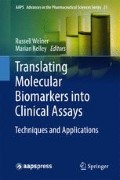Abstract
Flow cytometry is a highly versatile single cell analysis technology enabling multiparametric immune monitoring during clinical development . Cell data collected on morphology, activation state, and effector function from specific immune cell populations can be measured simultaneously in peripheral blood and/or tissue to determine drug efficacy. As such, flow cytometric laboratory testing is increasingly in demand to meet biomarker requirements for novel immunomodulatory biologics (IMBs) being evaluated in early and late stage clinical trials. In the context of clinical trial design, flow cytometric biomarkers may be used to assess safety, target engagement, and pharmacodynamics to enable clinical decision making. Flow cytometric applications such as immunophenotyping of TBNK immune cells is commonly employed as a safety biomarker to assess potential drug related immunotoxicities. IMB target engagement and pharmacodynamic effects on immune cell distribution and/or effector function can be integrated with traditional pharmacokinetic results to yield useful information relevant to dose selection, dosing intervals in addition to informing on mechanism of action. In all cases, a fit-for-purpose analytical validation is applied to flow cytometric assays prior to their clinical implementation to ensure confidence in biomarker measurements, while CRO placement of these assays offers a significant degree of standardization during clinical sample analysis to ensure high biomarker data quality.
Disclosure Statement
Richard Wnek is an employee of Merck & Co., Inc. and holds stock in the company.
Access this chapter
Tax calculation will be finalised at checkout
Purchases are for personal use only
Abbreviations
- Immunomodulatory biologic :
-
Biotherapeutic entities that target the activation or suppression of host immune responses as a means of disease treatment.
- Clinical development :
-
The clinical trials phase of drug development purposed with determining safety and efficacy of novel molecular entities.
- Flow cytometry :
-
Fluorescence based technology capable of simultaneously resolving phenotype and effector function of cells present in complex biological matrices.
- Immune monitoring :
-
Functional characterization and/or enumeration of immune cell subsets in peripheral blood and/or tissue.
References
Sathish JG, Sethu S, Bielsky MC et al (2013) Challenges and approaches for the development of safer immunomodulatory biologics. Nat Rev Drug Discov 12(4):306–324
Melero I, Grimaldi AM, Perez-Gracia JL, Ascierto PA (2013) Clinical development of immunostimulatory monoclonal antibodies and opportunities for combination. Clin Cancer Res 19(5):997–1008
Ascierto PA, Kalos M, Schaer DA, Callahan MK, Wolchok JD (2013) Biomarkers for immunostimulatory monoclonal antibodies in combination strategies for melanoma and other tumor types. Clin Cancer Res 19(5):1009–1020
Hamid O, Robert C, Daud A et al (2013) Safety and tumor responses with lambrolizumab (anti-PD-1) in melanoma. N Engl J Med 369(2):134–144
Brahmer JR, Drake CG, Wollner I et al (2010) Phase I study of single-agent anti-programmed death-1 (MDX-1106) in refractory solid tumors: safety, clinical activity, pharmacodynamics, and immunologic correlates. J Clin Oncol 28(19):3167–3175
Barnard RM (2012) Flow cytometry: a flexible tool for biomarker research. Bioanalysis 4(20):2471–2483
Fluge O, Bruland O, Risa K et al (2011) Benefit from B-lymphocyte depletion using the anti-CD20 antibody rituximab in chronic fatigue syndrome. A double-blind and placebo-controlled study. PLoS ONE 6(10):e26358
Sellam J, Hendel-Chavez H, Rouanet S et al (2011) B cell activation biomarkers as predictive factors for the response to rituximab in rheumatoid arthritis: a six-month, national, multicenter, open-label study. Arthritis Rheum 63(4):933–938
Lacey SF, Kalos M (2013) Biomarkers in T-cell therapy clinical trials. Cytotherapy 15(6):632–640
Guidi L, Felice C, Procoli A et al (2013) FOXP3(+) T regulatory cell modifications in inflammatory bowel disease patients treated with anti-TNFalpha agents. Biomed Res Int 2013:286368
Wang W, Yu D, Sarnaik AA et al (2012) Biomarkers on melanoma patient T cells associated with ipilimumab treatment. J Transl Med 10:146
Von Euw E, Chodon T, Attar N et al (2009) CTLA4 blockade increases Th17 cells in patients with metastatic melanoma. J Transl Med 7:35
Comin-Anduix B, Sazegar H, Chodon T et al (2010) Modulation of cell signaling networks after CTLA4 blockade in patients with metastatic melanoma. PLoS ONE 5(9):e12711
Koo GC, Shah K, Ding GJ et al (2003) A small molecule very late antigen-4 antagonist can inhibit ovalbumin-induced lung inflammation. Am J Respir Crit Care Med 167(10):1400–1409
Lapusan S, Vidriales MB, Thomas X et al (2012) Phase I studies of AVE9633, an anti-CD33 antibody-maytansinoid conjugate, in adult patients with relapsed/refractory acute myeloid leukemia. Invest New Drugs 30(3):1121–1131
Latek R, Fleener C, Lamian V et al (2009) Assessment of belatacept-mediated costimulation blockade through evaluation of CD80/86-receptor saturation. Transplantation 87(6):926–933
Wu DY, Patti-Diaz L, Hill CG (2010) Development and validation of flow cytometry methods for pharmacodynamic clinical biomarkers. Bioanalysis 2(9):1617–1626
Lee JW, Devanarayan V, Barrett YC et al (2006) Fit-for-purpose method development and validation for successful biomarker measurement. Pharm Res 23(2):312–328
O’hara DM, Xu Y, Liang Z, Reddy MP, Wu DY, Litwin V (2011) Recommendations for the validation of flow cytometric testing during drug development: II assays. J Immunol Methods 363(2):120–134
Hill CG, Mccloskey TW (2011) Flow cytometry outsourcing. Eur Biopharm Rev (Autumn 2011)
Author information
Authors and Affiliations
Corresponding author
Editor information
Editors and Affiliations
Rights and permissions
Copyright information
© 2016 American Association of Pharmaceutical Scientists
About this chapter
Cite this chapter
Wnek, R., Tseng, M., Wu, D. (2016). Current Flow Cytometry Methods for the Clinical Development of Immunomodulatory Biologics. In: Weiner, R., Kelley, M. (eds) Translating Molecular Biomarkers into Clinical Assays . AAPS Advances in the Pharmaceutical Sciences Series, vol 21. Springer, Cham. https://doi.org/10.1007/978-3-319-40793-7_13
Download citation
DOI: https://doi.org/10.1007/978-3-319-40793-7_13
Published:
Publisher Name: Springer, Cham
Print ISBN: 978-3-319-40792-0
Online ISBN: 978-3-319-40793-7
eBook Packages: Biomedical and Life SciencesBiomedical and Life Sciences (R0)

